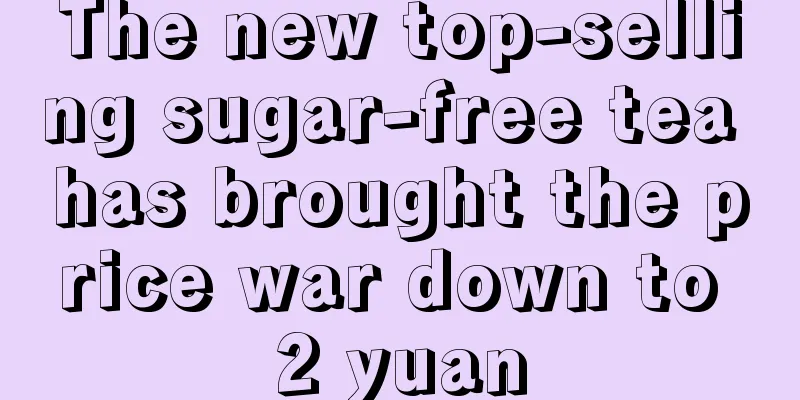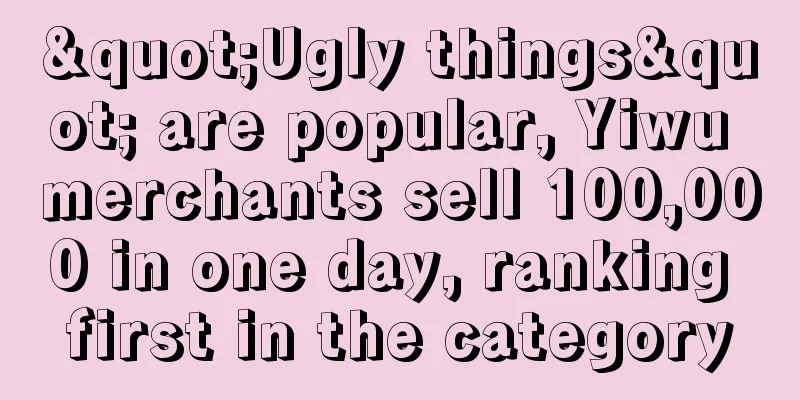The new top-selling sugar-free tea has brought the price war down to 2 yuan

In the summer of 2024, sugar-free tea became the new top trend in the tea beverage market. Nielsen IQ data shows that in 2023, ready-to-drink tea, including sugar-free tea, will take 21.1% of the market share, surpassing carbonated beverages (18.5%) for the first time and ranking first in the industry. At the same time, the growth rate is also gratifying. In 2023, the growth rate of ready-to-drink tea, including sugar-free tea, will reach 110%. According to data from iResearch, the CAGR of sugar-free tea drinks will reach 10.2% from 2022 to 2027, and the market size is about to reach 10 billion yuan. In the next five years, China's tea drink market will enter a period of rapid growth for sugar-free tea drinks. From the perspective of the market structure, not only are old companies such as Suntory and Oriental Leaves holding their ground, but new brands such as Yuanqi Forest and Guozishule have also emerged. Since the beginning of this year, cross-border players such as Master Kong, Dayao, Uni-President, Coca-Cola, and Tsingtao Beer have also joined the market competition for sugar-free tea. Major tea brands are competing to launch their own sugar-free tea products in order to gain a place in this "Thousand Tea War". Just when the sugar-free tea market seemed to be booming and about to enter a golden period of development, a sudden price war quietly broke out. In order to compete for market share, major new and old brands have adopted the strategy of price reduction and promotion. The price range of sugar-free tea has quickly moved from the original 5-6 yuan/bottle to 3-4 yuan/bottle. Some products have even broken the price bottom line of 3 yuan, moving towards the price range of mineral water. So why did the newly emerging sugar-free tea category quickly fall into such a fierce price war? After this round of price war, where will sugar-free tea go? 1. Why do you start fighting as soon as you become a top star?Compared with the competition in the bottled water market, the competition in the sugar-free tea market is equally fierce, or even more so. The author has recently observed that major brands have frequently launched various promotional activities in prominent locations such as shelves and refrigerators in offline shopping malls and convenience stores. Specifically, Oriental Leaves, which originally cost 6.5 yuan for 500ml, is now offering super value discounts of 7.5 yuan/2 bottles and 10 yuan/3 bottles; Suntory sugar-free and low-sugar oolong tea, which originally cost 5.5 yuan for 500ml, is now offering a special promotion of 7 yuan/2 bottles; Chun Cha She 480ml and Uni-President Chunfu Green Tea 500ml, which originally cost 5.5 yuan, can be purchased at an extra price of 1 yuan for an extra bottle. In other words, the price of each bottle is only between 3 yuan and 4 yuan. On online platforms, the price war for sugar-free tea is getting more intense, with the price of some products even falling below the 3 yuan mark. For example, on e-commerce platforms such as Taobao, a set of 12 bottles of 500ml sugar-free tea from Guozishule is priced at only 35.1 yuan, equivalent to only about 2.9 yuan per bottle; the price of Suntory sugar-free oolong tea of the same specification has even dropped to a low price of 2.8 yuan per bottle. So why is the price war in the sugar-free tea market so fierce? There are four main reasons behind this: 1. The production technology and threshold of sugar-free tea are relatively lowThe production technology and threshold of sugar-free tea are relatively low, resulting in no significant differentiation among brands in terms of raw materials, origin, taste, packaging, etc. In order to stand out from many competitors, brands have to compete for market share through price wars. 2. The sugar-free tea industry has broad development prospectsAs the overall growth rate of the beverage industry slows down, companies are actively looking for new growth points. The dark horse of the industry, Oriental Leaves, made a lot of money last year. According to Nielsen data, it can be roughly inferred that Oriental Leaves grew by more than 100% last year, and the compound growth rate in the past three years exceeded 90%. The success of Oriental Leaves has undoubtedly given the entire industry a shot in the arm, attracting more brands to enter the sugar-free tea market. This fierce competition has further intensified the price war. 3. Consumers’ consumption concepts are becoming more rationalCost-effectiveness has become an important consideration for consumers when choosing goods. With the trend of consumption downgrade, consumers are more cautious in choosing daily consumer goods such as beverages, and are more inclined to buy products that are moderately priced and reliable in quality. Therefore, the high pricing level of sugar-free tea in the past is unlikely to attract a large number of consumers, and brands are reducing prices to cater to consumer demand. 4. China's sugar-free tea market has gone through a stage from initial introduction to steady growthMajor brands are actively competing for market share. If a brand wants to gain market share and consumer recognition in a short period of time, price war is the fastest and most effective means. Summer is also the peak season for soft drink sales, so the price war for sugar-free tea is launched at this time, which is more in line with the market's sales logic. The sugar-free tea market is full of competitors, and the "Thousand Tea War" has begun. Both established companies and emerging brands are fighting fiercely through the marketing method of "trading price for volume". At present, purified water seems to have become the "cannon fodder" in the fierce competition among giants. What will be the future of sugar-free tea? 2. With prices, new products and specifications rolled up, will the next step for sugar-free tea be to become a “water substitute”?According to Bloomberg data, the retail sales of sugar-free tea in Japan and South Korea account for 82.5% and 79.1% of their total tea retail sales respectively, while in China this proportion is only 9.5%. This shows that China's sugar-free tea market still has broad room for expansion and development potential in the future. Nowadays, the competition in sugar-free tea is not only limited to price wars, but also reflects the in-depth competition in product innovation and market strategies. On the one hand, sugar-free tea brands have accelerated the launch of new products. According to Mashangying data, 10 manufacturers have launched 34 new sugar-free tea products this year, including Suntory's wheat tea, Uni-President's Chunfu green tea, Master Kong's sugar-free jasmine tea, sugar-free oolong tea, Wahaha's Dahongpao and Qinggan Pu'er, etc. On the other hand, sugar-free tea brands have also begun to increase the size of their products, and have launched large-size packaging to improve their cost-effectiveness, striving to become the "water substitute" for young people. This trend is particularly evident in brands such as Oriental Leaves, Coca-Cola Chunchashe, and Yuanqi Forest Tea, all of which have launched 900ml large-bottle products. Mashangying data also shows that from April to May, among all business formats, the 900ml specification of Nongfu Spring Oriental Leaves products has achieved double-digit growth, while the 500ml specification has declined to varying degrees. So, in the red ocean of the sugar-free tea industry, what is the competitiveness of major brands? In fact, since there are no significant barriers to the production technology and raw materials of sugar-free tea at this stage, brand power and channel penetration become the key to determining success or failure. Brands with a strong channel network, especially those with offline terminal layout, can stand out in the fierce market competition. Because sugar-free tea beverages are low-priced and heavy, and have impulse consumption attributes, sugar-free tea is more dependent on offline than online, but offline channels generally lock the entire ice rink or half of the ice rink to big brands all year round. Looking back at the development trajectory of the sugar-free sparkling water market, we can find a similar competitive logic. In the early days of the sparkling water market, many small and medium-sized brands flooded into the market, but with the intervention of traditional beverage brands and the double blow of price wars and marketing wars, most small and medium-sized brands have been eliminated. Today, only big brands of sparkling water such as Yuanqi Forest, Coca-Cola, and Pepsi are left in the freezers of convenience stores. The same is true for the sugar-free tea market. At present, Oriental Leaves and Suntory occupy a leading position in the sugar-free tea market, with their combined market share exceeding 75%, forming a relatively stable dominant position. The market share that latecomers can compete for is relatively limited, and it is not easy to get a piece of the pie. After excessive internal competition, the industry's highly concentrated market leaves little room for development for new brands and new products in the track, and their survival space in the future may be squeezed even more severely by leading brands. Author: Ning Chengque Source: WeChat public account "Bohu Finance" |
>>: The market offers free cooking services! A number of restaurants are completely panicked...
Recommend
Business analysis, how to diagnose business problems
This article starts from the business diagnosis of...
How to settle cash on delivery payment on Lazada? FAQ
Lazada is also a kind of cross-border e-commerce p...
Entrepreneur IP needs to evolve from a "traffic actor" to a "spiritual leader"
In the digital age, the influence of entrepreneurs...
Why WeChat's "Little Green Book" cannot threaten Xiaohongshu? Let's start with how to analyze a content platform
Recently, WeChat has made another big move. WeChat...
Can e-commerce support the future of Xiaohongshu?
Xiaohongshu has been making frequent moves since i...
What is the URL of Amazon's North American site? Which countries are Amazon's North American sites in?
As the wave of digitalization sweeps the world, cr...
Shopee may close its Polish business
Shopee, a Southeast Asian e-commerce giant owned b...
Is it profitable to do cross-border e-commerce on Shopee? Is it reliable?
To open a store on the Shopee platform, after sele...
How to optimize Shopee orders? How to optimize click-through rate?
In the early stage of opening a store on the Shope...
Is self-operated e-commerce back on the rise?
An integrated retail-supply relationship with smoo...
Millions of people check in to enjoy the hustle and bustle of life. Will live streaming + setting up stalls be a new business?
Have you ever watched live broadcasts of night mar...
With 17 million fans, middle-aged and elderly people also love to "chase stars"
A piece of social news one month ago made a Douyin...
The "homeless man" with 4.4 million fans on the Internet has become the "Northeast Ranger" in the hearts of netizens
A while ago, the issue of nuclear wastewater disch...
It’s not Pinduoduo that defeats Alibaba!
Pinduoduo's market value surpassed Alibaba? Wh...
A brief history of CEO live streaming in China
The birth of the Internet PR industry is closely r...









